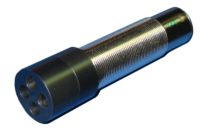Material sensors tri²dent: the innovation from Sensorik Austria
The tri²dent material sensors from Sensorik Austria are causing a revolution in industrial sensor technology: while conventional sensors previously only detected the presence and at most also the color of an object, the tri²dent sensor now also enables the identification and differentiation of objects based on their material composition! But that's not all: it also makes it possible to monitor ingredients or control material application during coating processes.
Find out more about the diverse possible uses and how material sensors work!

Many possibilities thanks to new material sensors
The newly developed tri²dent material sensor is the first compact material sensor at all! While the characterization of (organic) materials was previously only possible in the laboratory or using expensive process spectrometers, the tri²dent sensors now also allow this in industrial process monitoring through the use of a simplified spectrometric principle.
A material sensor can take on the following functions:
- Identification and differentiation of different (organic) materials, such as the differentiation of plastics or plastic from paper etc.
- Monitoring of material application during coating processes
- Measuring the concentration of ingredients in transparent or semi-transparent materials
But how does a tri²dent material sensor work? We have them for you Functionality briefly summarized:
- Most organic materials have characteristic absorption profiles in the near-infrared range, meaning that at certain wavelengths they absorb more light (=absorption band) than at others.
- In order to use this, the absorption bands of the materials to be identified must be determined so that the sensor can be equipped with suitable light sources.
- The sensor emits up to three infrared rays of different wavelengths, which are absorbed by the illuminated materials according to their absorption profiles.
- The reflected light from the three channels, reduced by the absorption, is evaluated by the sensor. By comparing it with the taught material values, the sensor can now draw conclusions about the respective material.
- The sensor passes its result on to the process control system. Depending on the task, it outputs either a binary output signal - material XY is present or not present - or an analog output signal - corresponds to a material ID or a concentration in percent.
In conjunction with special, high-quality quartz glass fiber optics, tri²dent enables material detection even in high-temperature areas and measuring points that are difficult to access. Even high environmental pollution does not pose a problem.
But also discover our other sensors: From high-performance photo sensors to color sensors and speed sensors, we offer you specialists for demanding industrial process monitoring projects. Do you have any questions or would you like expert advice? Get in touch with us, we will be happy to help you!
Sensorik Austria GmbH – your professional for sensor solutions
In conjunction with special, high-quality quartz glass fiber optics, tri²dent enables material detection even in high-temperature areas and measuring points that are difficult to access. Even high environmental pollution does not pose a problem.
But also discover our other sensors: From high-performance photo sensors to color sensors and speed sensors, we offer you specialists for demanding industrial process monitoring projects. Do you have any questions or would you like expert advice? Get in touch with us, we will be happy to help you!

 + 43 7245 / 22 001 13
+ 43 7245 / 22 001 13 office(@)sensorikaustria.com
office(@)sensorikaustria.com